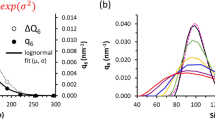Abstract
Evidence that a model of hard spheres exhibits a first-order solid-fluid phase transition was provided in the late fifties by two new numerical techniques known as Monte Carlo and Molecular Dynamics. This result can be considered as the starting point of computational statistical mechanics: at the time, it was a confirmation of a counter-intuitive (and controversial) theoretical prediction by J. Kirkwood. It necessitated an intensive collaboration between the Los Alamos team, with Bill Wood developing the Monte Carlo approach, and the Livermore group, where Berni Alder was inventing Molecular Dynamics. This article tells how it happened.
Similar content being viewed by others
References
Alder B. J. 1990, Interview of Berni Alder by G. Battimelli and D. Frenkel on the American Institute of Physics web site, https://www.aip.org/history-programs/niels-bohr-library/oral-histories/30662
Alder B. J. 1992, in Microscopic Simulations of Complex Hydrodynamic Phenomena, edited by M. Mareschal and B. L. Holian (Plenum Press, New York): pp. 425–430
Alder B. J. and Wainwright T. E. 1957, J. Chem. Phys. 27: 1208–1209
Alder B. J. and Wainwright T. E. 1958, Molecular Dynamics by Electronic Computers, in International Symposium on the Statistical Mechanical Theory of Transport Processes, Brussels, 1956, edited by I. Prigogine (Interscience, New York): pp. 97–131
Alder B. J. and Wainwright T. E. 1959, Mol. Mot. Sci. Am. 201: 113–126
Alder B. J. and Wainwright T. E. 1963, Investigation of the Many-Body Problem by Electronic Computers, Chap. 29 in The Many-Body Problem, edited by J. K. Percus (Interscience, New York): pp. 511–522. See also the verbatim transcription of the discussions of the round table on statistical mechanics: pp. 493–509
Alder B. J., Frankel S. P. and Lewinson V. A. 1955, J. Chem. Phys. 23: 417
Anderson H. L. 1987, Los Alamos Sci. 14: 96
Bernard E. P. and Krauth W. 2011, Phys. Rev. Lett. 107: 155704
Ciccotti G. and Ferrario M. 2017, Private communication
Ciccotti G., Frenkel D. and McDonald I.R. (Eds.) 1987, Simulation of Liquids and Solids (North-Holland, New York)
Dauxois T., Peyrard M. and Ruffo S. 2005, Eur. J. Phys. 26: S3–S11
Feller W. 1970, An Introduction to Probability Theory and its Applications, Vol. 1, 3rd edn. (J. Wiley, New York)
Gubernatis J. 2005, Phys. Plasma 12: 057303
Kirkwood, J. G. 1951, Crystallization as a Cooperative Phenomenon, in Phase Transformations in Solids, edited by R. Smoluchowski, J. E. Mayer and W. A. Weyl (Wiley, New York): pp. 67–76
Kosterlitz J.M. 2017, in Proceedings of the Symposium in Honor of Dr. Berni Alder’s 90th Birthday, Advances in the Computational Sciences, edited by E. Schweger, B. M. Rubenstein and S. B. Libby (World Scientific)
Lebowitz J. L., Percus J. K. and Verlet L. 1967, Phys. Rev. 153: 250
Metropolis N. 1987, Los Alamos Rev. 15: 125–130
Metropolis N. and Ulam S. 1949, J. Am. Stat. Assoc. 44: 335–341
Metropolis N., Rosenbluth A. W., Rosenbluth M. N., Teller A. H. and Teller E. 1953, J. Chem. Phys. 21: 1087–1092
Press, W. H., Teukolsky S. A., Wetterling W. T. and Flannery B. P. 2007, in Numerical Recipes: The Art of Scientific Computing, 3rd edn. (Cambridge University Press, New York)
Rahman A. 1964, Phys. Rev. 136A: 405
Rosenbluth M. N. 2003, Marshall Rosenbluth, interview by K.-H. Barth on the AIP web site, within the Niels Bohr Library and Archives, https://www.aip.org/history-programs/niels-bohr-library/oral-histories/28636-1
Rosenbluth M. N. and Rosenbluth A. W. 1954, J. Chem. Phys. 22: 881–884
Verlet L. 1990, The Origins of Molecular Dynamics, in In Memoriam Aneesur Rahman, available from the Cecam web site’s archives, https://www.cecam.org/img/archive/In_Memoriam_Aneesur_Rahman.pdf
Wainwright T.E. and Alder B. J. 1958, Nuovo Cimento Suppl. 9: 116
Wood W. W. 1986, Early History of Computer Simulations in Statistical Mechanics, in Molecular-Dynamics Simulation of Statistical-Mechanics Systems, edited by G. Ciccotti and W. G. Hoover (North-Holland, New York): pp. 3–14
Wood W. W. 1996, Chap. 36 in Monte Carlo and Molecular Dynamics of Condensed Matter Systems, edited by K. Binder and G. Ciccotti (Italian Physical Society): pp. 908–911
Wood W. W. and Jacobson J. D. 1957, J. Chem. Phys. 27: 1207–1208
Wood W. W., Parker F.R. and Jacobson J. D. 1958, Nuovo Cimento Suppl. 9: 133
Author information
Authors and Affiliations
Corresponding author
Rights and permissions
About this article
Cite this article
Mareschal, M. Early years of Computational Statistical Mechanics. EPJ H 43, 293–302 (2018). https://doi.org/10.1140/epjh/e2018-90006-7
Received:
Revised:
Published:
Issue Date:
DOI: https://doi.org/10.1140/epjh/e2018-90006-7




